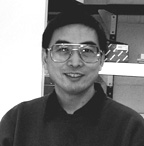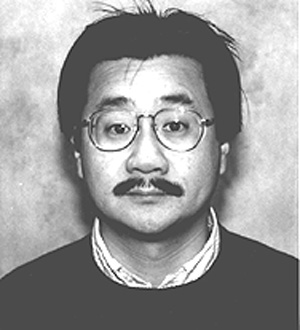
| T H E N I H C A T A L Y S T | J A N U A R Y - F E B R U A R Y 1999 |
|
|
|
| P E O P L E |
 |
|
Ding
Jin
|
Ding J. Jin received his Ph.D. from the University of Wisconsin–Madison in 1988 and did postdoctoral work there until joining the NCI Laboratory of Molecular Biology in 1991. He is currently a senior investigator.
The goal of my research program is to understand the transcription machinery and its mechanism using Escherichia coli as a model system. Regulation of transcription is a key step in controlling gene expression in all cells. The basic structure and function of RNA polymerase (RNAP)/RNAP-associated proteins are conserved throughout evolution.
The sophisticated genetics and advanced biochemistry of the E. coli system facilitate the analysis of structure-function relationships of RNAP and the elucidation of transcription mechanisms at the molecular level. E. coli RNAP exists in two forms: core (a2bb’) and holoenzyme (a2bb’s). While core RNAP is capable of transcription elongation and termination, initiation requires a sigma-containing holoenzyme. There are multiple sigma factors in E. coli, and each holoenzyme specifically recognizes a set of genes (a regulon).
Thus, the binding of core RNAP with sigma factors to form different holoenzymes is, operationally, the first step in transcription initiation, and a critical step in controlling global gene expression. An ongoing project in my laboratory is to investigate the interplay between core RNAP and sigma factor(s), with an emphasis on the role of core RNAP. We have developed genetic systems to identify the sites in core RNAP that bind to sigma factors and the elements that influence the interaction between core RNAP and sigma factors.
We have identified other site(s) in RNAP that are important for RNAP functions. For example, we showed that the antibiotic rifampicin-binding sites in RNAP are involved in transcription initiation, in addition to elongation and termination as previously described, indicating that they are at or near the catalytic center of RNAP.
We found that b and b’ RNAP mutants altered interaction with promoters, demonstrating that transcription initiation is a concerted action of sigma factor(s) and core RNAP.
Recently, we identified a novel RNAP-associated protein, RapA. RapA, a bacterial homolog of SWI2/SNF2 family, is an ATPase. We showed that RapA forms a stable complex with RNAP and that binding to RNAP stimulates its ATPase activity, thus demonstrating that the two proteins interact physically as well as functionally. Currently, we are studying the regulation of the rapA gene and the function of RapA inside the cell.
Promoter clearance is a transition step between transcription initiation and elongation, during which RNAP also synthesizes nonproductive initiation products at many promoters.
By studying the mutant RNAPs that altered productive and nonproductive initiation, I illustrated that promoter clearance is a rate-limiting step for gene expression at some promoters. Also, I demonstrated that the rate of incorporation of initially transcribed nucleotide(s) at a critical position in nascent RNA determines the switch between nonproductive and productive syntheses during promoter clearance, indicating a kinetic mechanism analogous to the regulation of elongation and termination-antitermination. Recently we have focused on the mechanism of the stringent (nutrient starvation) response, an important but poorly understood biological process. By analysis of the mutant RNAPs that exhibited a nutrient starvation response phenotype even in rich media, we demonstrated that modulation of the stability of open complexes between RNAP and stringent promoters is a regulatory step.
We proposed a new model to link transcription and the stability of the initiation complexes at this class of promoters, and to account for differential distribution of RNAP molecules to different sets of genes in response to environmental cues (nutrient richness or starvation) in the cell.
Our hypothesis thus provides a basis for further experiments to determine the cis and trans elements important for coordinated regulation of the nutrient starvation response.
 |
|
Minoru
Ko
|
Minoru S. H. Ko received his M.D. degree in 1986 and his Ph.D. in 1991 from Keio University School of Medicine in Tokyo. He was a tenured associate professor at the Center for Molecular Medicine & Genetics at Wayne State University in Detroit until 1998, when he arrived at NIA, where he is now head of the Developmental Genomics and Aging Section, Laboratory of Genetics.
My research interest is in the mechanisms of cell differentiation in early mammalian development, in terms of global gene regulatory networks and cascades. In one earlier study, using a steroid hormone inducible gene, I demonstrated a stochastic component in the regulation of expression of individual genes at a single cell level. I have also developed three methods that aid in profiling systematic gene expression in specific cell types. These are: 1) PCR-based amplification of a complex mixture of cDNAs, which allows the analyses of a cohort of genes expressed in the small number of cells; 2) a way to construct a normalized cDNA library in which the abundance of individual cDNA species is equalized; and 3) an efficient PCR-based method for localizing mouse cDNAs or expressed sequence tags (ESTs) on the genetic map.
These methods, combined with high-throughput DNA sequencing technology, have allowed my group to generate many developmental and tissue-specific cDNA libraries, including more than 30,000 ESTs, with 1,000 new genes placed on the mouse genetic map, over the last 5 years. The cDNA clones and ESTs are derived from preimplantation and peri-implantation mouse embryos. We are using the ESTs both for expression profiling of special cell types and for map-driven gene discovery. In further steps to understand gene regulatory networks, we use selected cDNAs as probes for in situ hybridization to mouse embryonic and fetal preparations, and we organize microarrays of sets of the cDNA clones for systematic analysis of coexpression patterns.
As a model system, we have been using extraembryonic tissue development. The first differentiation event in mammalian embryos generates two distinct lineages: the trophectoderm (TE) and the inner cell mass (ICM). The ICM will eventually become most of the embryo proper, while the TE will eventually become the extraembryonic tissues such as placenta. While analyzing a cohort of genes expressed in the ectoplacental cone, a derivative of the TE, from the 7.5-day postconception (dpc) mouse embryo, we have found that notable subsets of genes are clustered in subregions of the mouse genome. Most prominent is the t-complex, which has been a focus of research for a half century because of unique features including the presence of many embryonic lethal mutant loci and large inversions of the genomic regions. We speculate that clustering is associated with both coexpression and monoallelic expression of genes. We are currently sequencing the genome segment of mouse t-complex.
One aspect of extraembryonic
tissue development is directly relevant to a classic problem in aging research:
the difference between "mortal" and "immortal," or pluripotent,
cells. The ICM cells of mouse embryos at 3.5 dpc can indeed grow indefinitely
in culture, whereas the outer layer (TE) cells are already limited in lifespan.
We are applying the gene-profiling methods and gene cohorts we have developed
to compare gene expression in the two types of cells in the hope of identifying
genes that turn on or off to initiate "mortality."
![]()